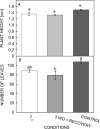Morphophysiological responses of black pepper to recurrent water deficit
- PMID: 39649363
- PMCID: PMC11622609
- DOI: 10.32615/ps.2024.030
Morphophysiological responses of black pepper to recurrent water deficit
Abstract
This study investigated the effects of recurrent water deficit on drought tolerance traits in black pepper (Piper nigrum L.) 'Bragantina'. Plants were subjected to three cycles of water deficit followed by recovery periods. Water deficit reduced stomatal conductance, photosynthesis, transpiration, and water potential while increasing water-use efficiency. In addition, intercellular CO2 concentration, leaf temperature, root starch, and adaptive morphological characteristics in leaves and roots increased. Despite these adaptations, plants did not recover vegetative growth after rehydration. The primary tolerance mechanisms observed included increased abaxial epidermis thickness, stomatal density, fine roots, periderm thickness, and starch accumulation in roots. Although gas exchange and leaf water potential were restored, vegetative growth did not fully recover. This study highlights the response of black pepper to recurrent water stress and the underlying mechanisms of its drought tolerance.
Keywords: anatomy; black pepper; drought cycles; gas exchange; vegetative growth.
Copyright: © 2024 Ferreira et al.
Conflict of interest statement
The authors declare that they have no conflict of interest.
Figures



References
-
- Ambrozim C.S., Furtado J.G., Valani R.S. et al.: [Propagation of black pepper in different concentrations of indolebutyric acid.] – Rev. Ifes Ciênc. 3: 17-28, 2017. [In Portuguese] 10.36524/ric.v3i2.322 - DOI
-
- Ambrozim C.S., Medici L.O., Cruz E.S.D. et al.: Physiological response of black pepper (Piper nigrum L.) to deficit irrigation. – Rev. Cienc. Agron. 53: e20207348, 2022. 10.5935/1806-6690.20220002 - DOI
LinkOut - more resources
Full Text Sources
